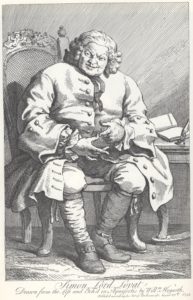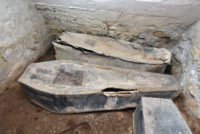 Simon Fraser, 11th Lord Lovat, was the last man to be beheaded in Britain. Fraser, Chief of Clan Fraser, was known as a wily wheeler-dealer, hence his nickname “The Old Fox.” He tried to play both sides throughout the conflicts of the 18th century and while he was nominally on the Jacobite side during the 1745 uprising, he told the English he wasn’t just to keep his options open (i.e., cover his ass in case it all went to hell in a handbasket, as it did). His clan was on the front lines at the Battle of Culloden on April 16th, 1746, bearing the brunt of the Hanoverian assault. Lord Lovat himself was not among them. He was 80 years old, morbidly obese and afflicted with, among other ailments, gout and arthritis, so he wasn’t exactly fighting fit, but he was also playing the odds. He told the English that his son Simon had fought with the Jacobites against his wishes.
Simon Fraser, 11th Lord Lovat, was the last man to be beheaded in Britain. Fraser, Chief of Clan Fraser, was known as a wily wheeler-dealer, hence his nickname “The Old Fox.” He tried to play both sides throughout the conflicts of the 18th century and while he was nominally on the Jacobite side during the 1745 uprising, he told the English he wasn’t just to keep his options open (i.e., cover his ass in case it all went to hell in a handbasket, as it did). His clan was on the front lines at the Battle of Culloden on April 16th, 1746, bearing the brunt of the Hanoverian assault. Lord Lovat himself was not among them. He was 80 years old, morbidly obese and afflicted with, among other ailments, gout and arthritis, so he wasn’t exactly fighting fit, but he was also playing the odds. He told the English that his son Simon had fought with the Jacobites against his wishes.
He was still trying to hide behind that dodge after the Battle of Culloden ended in disaster for the pro-Stuart Highlanders. It didn’t work then either. The Old Fox was captured a few months later and taken to the Tower of London. In March of 1747, he was put on trial for treason. The outcome was unsurprising: he was convicted and sentenced to decapitation. On April 9th, 1747, he was led to the gallows, laughed when he saw nine people killed when one of the wooden bleachers collapsed, quoted Horace’s Odes and took leave of his head.
The story takes a bit of a turn after that. Although the chief had asked that his body be returned to his family cemetery and the authorities had agreed, they thought better of it after the beheading. Figuring his remains and tomb would become a focal point for Jacobite Scots to plot rebellion, they buried the body of Simon Fraser under the Tower chapel floor. There was a gap, though, a full nine days between his execution and his burial to allow for viewing of the body. According to Clan Fraser lore, his body was purloined during those nine days and smuggled back to Scotland where it was secretly buried at Wardlaw Mausoleum, the Fraser family cemetery in Kirkhill, near Inverness.
 The contradictory stories came to the forefront again in the 19th century when the coffins under the Tower chapel were disinterred and one of them had Lord Lovat’s name on it. More recently, however, there was a stirring on the other side of the Force when a headless body was discovered in an expensive double lead casket at the cemetery. Could the tales be true? Were these The Old Fox’s remains, snatched out from under England’s very nose?
The contradictory stories came to the forefront again in the 19th century when the coffins under the Tower chapel were disinterred and one of them had Lord Lovat’s name on it. More recently, however, there was a stirring on the other side of the Force when a headless body was discovered in an expensive double lead casket at the cemetery. Could the tales be true? Were these The Old Fox’s remains, snatched out from under England’s very nose?
Science’s representative in this matter was forensic anthropologist Professor Dame Sue Black who was engaged to study the remains thoroughly, from osteological analysis to DNA testing, to answer conclusively whether this headless body was THE headless body of the 11th Lord Lovat. The answer is no. The remains are of a young woman in her late 20s or early 30s at the time of her death.
Professor Black, Director of the Centre for Anatomy and Human Identification at the University of Dundee, said: “We can say with absolute certainty that these are not the remains of The Old Fox.
“The remains were in poor condition, very wet, in common with remains that have been a long time in a wooden or lead coffin, so in line with what we expected.
“The area of the body most indicative of whether remains are male or female is the shape of the pelvis, and two areas of the pelvis in particular. In both areas, these remains are very feminine. There is no way that these were the remains of an 80-year-old six-foot man who suffered from gout and arthritis.
“We estimate these are the remains of a young woman, probably aged 25–35. We understand that there are some possibilities that she might be a member of the Fraser family, and further DNA testing is being carried out.” […]
Professor Black added: “We simply don’t know what happened to the head, but it may be that it has been taken as a trophy many years ago. The DNA testing should confirm whether the remains are those of a member of the Fraser family, in which case the casket may well have simply been put to use. But if the remains are not a member of the family, then we are faced with more of a poser as to how she came to be buried in the casket.”